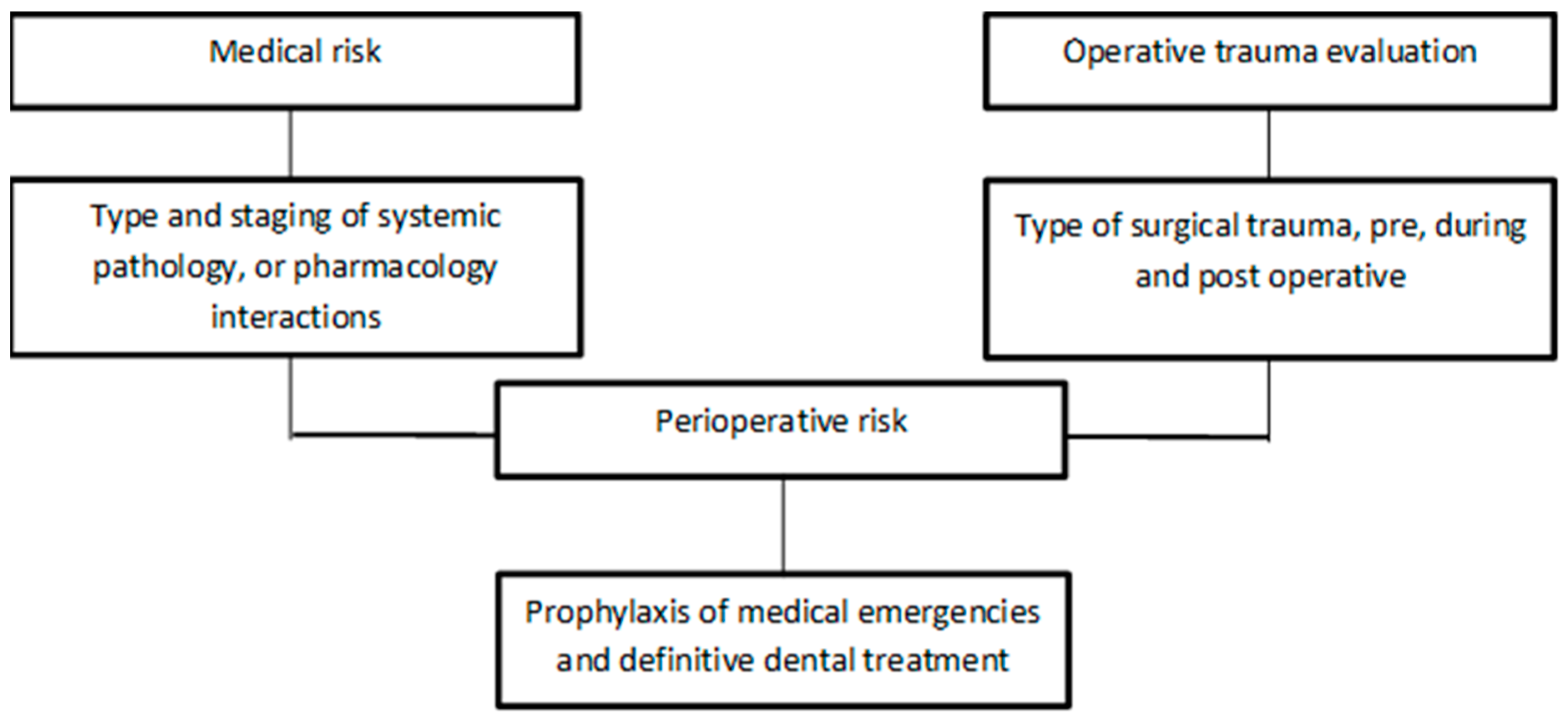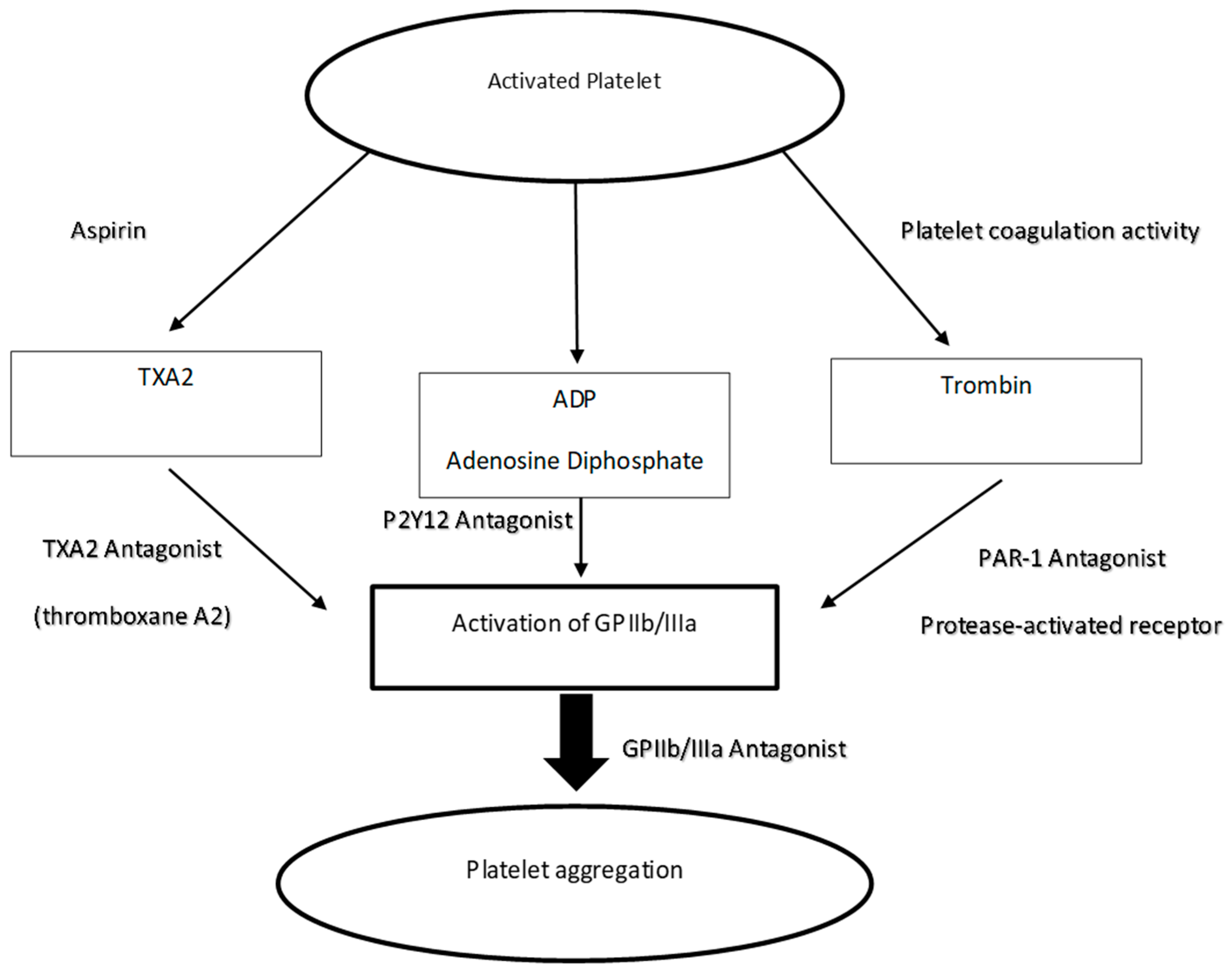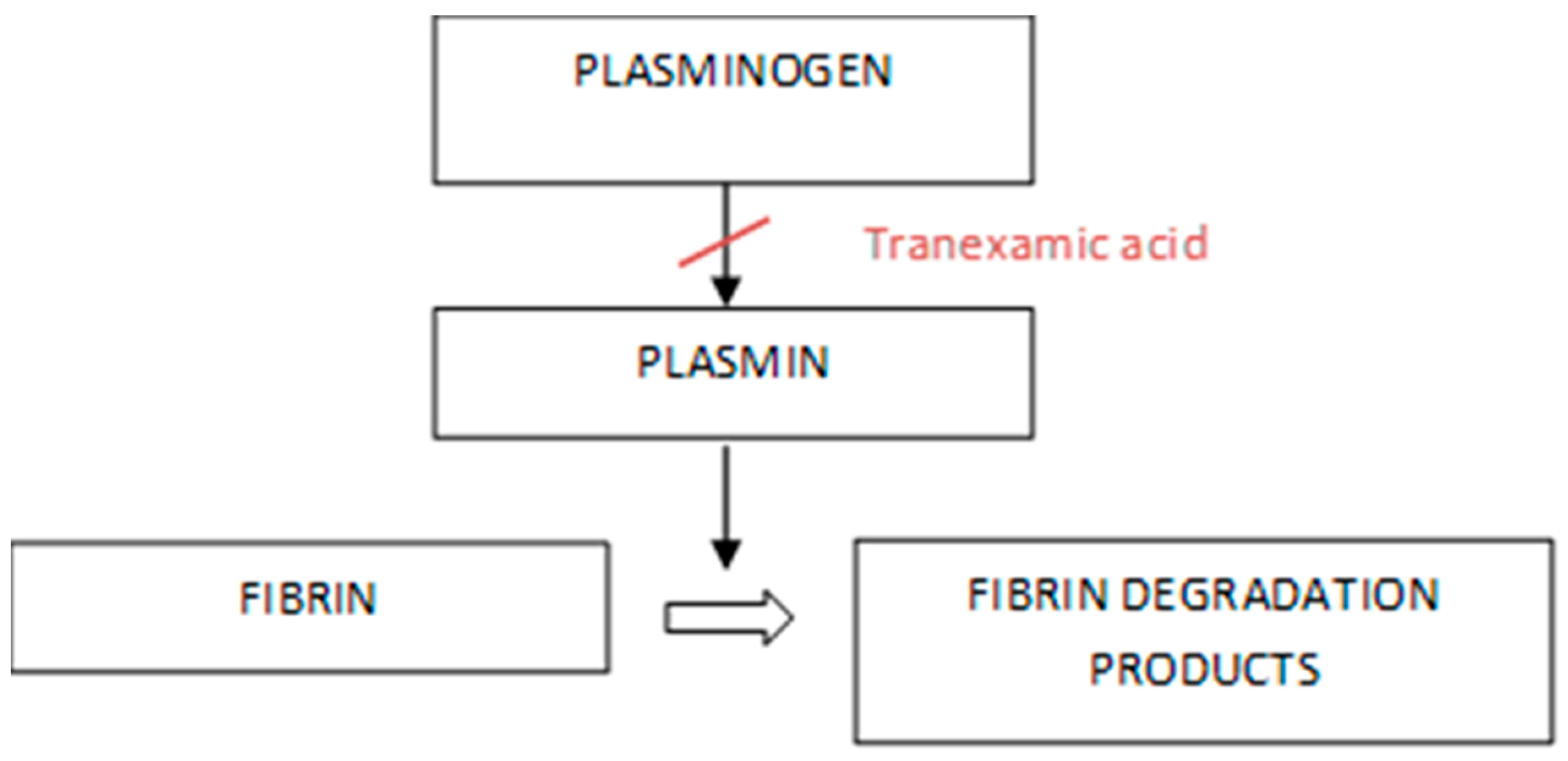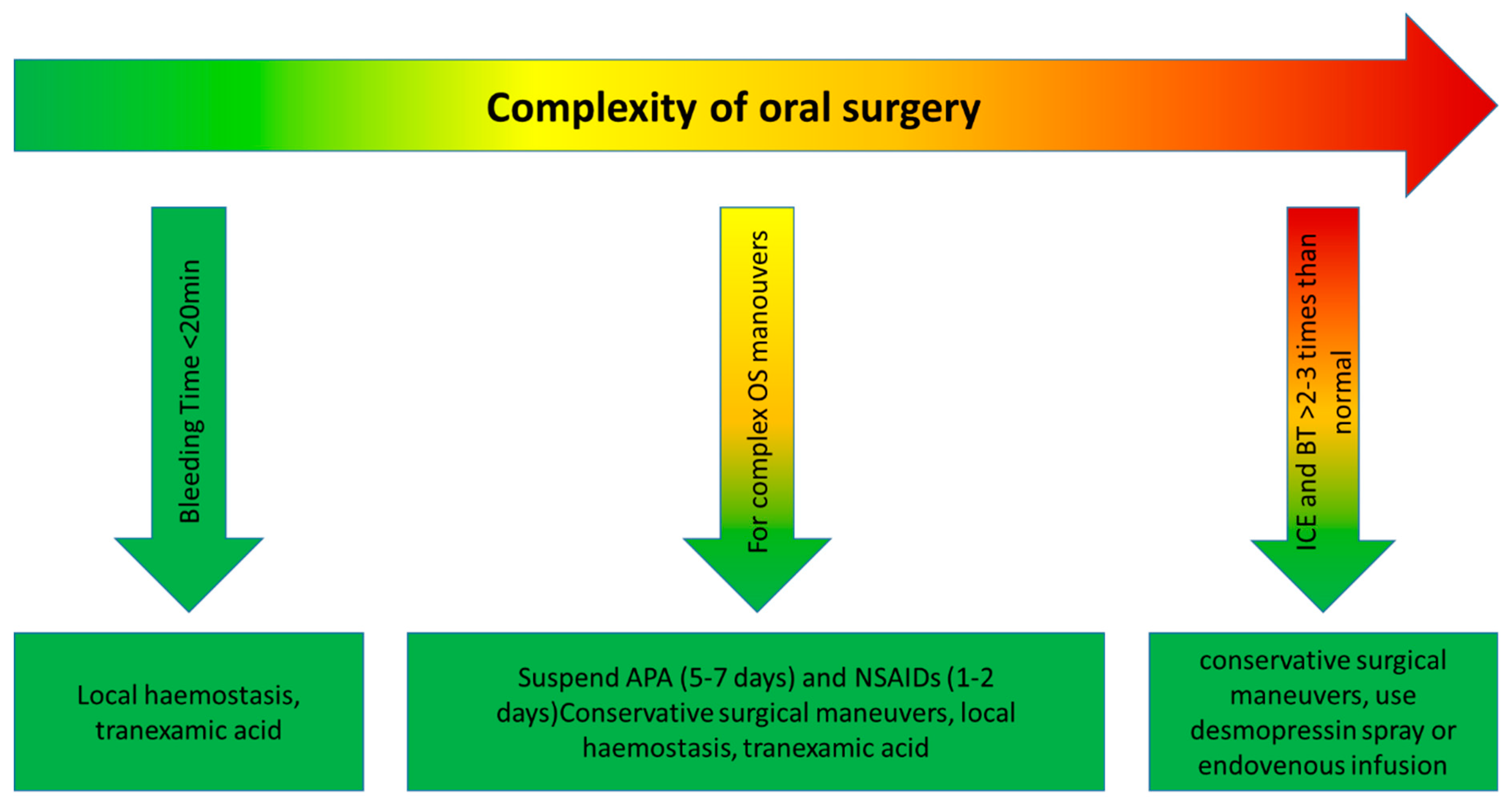Advances in Antiplatelet Therapy for Dentofacial Surgery Patients: Focus on Past and Present Strategies
Abstract
1. Introduction
2. Materials and methods
2.1. Review Parameters
2.1.1. Focus Questions
2.1.2. Information Sources
2.1.3. Search
2.1.4. Inclusion and Exclusion Criteria
- Study of patients with antiplatelet therapy.
- Study of patients with dual or new antiplatelet drug therapy.
- Studies involving patients with other specific diseases, immunologic disorders, uncontrolled diabetes mellitus, osteoporosis, or multi-therapy.
- Not enough information regarding the selected topic, no information about oral status and oral health or pharmacological therapy.
- No access to the title and abstract in English language or letters and editorials.
- Animal studies.
- Not full text articles.
2.1.5. Risk of Bias Assessment
2.2. Type of Anti-Platelet Drugs
- Cellular mechanism: the white blood cells present near the clot release enzymatic substances capable of dissolving the clot; and
- Plasmatic mechanism: the fundamental step of this mechanism is the transformation of plasminogen into plasmin.
2.2.1. Past Protocols Collection
- you should contact the following phone number…; or
- in case of absence, do not hesitate to show up at the hospital emergency service (public, private), or consult your own physician [1].
2.2.2. Today’s Protocols
2.3. Type of Pathology That Needs This Therapy
2.3.1. Type of Oral Surgery Intervention That May Have a Bleeding Risk
- Depressors of the central nervous system (alcohol, antidepressants, sedatives—-respiratory and CNS depression;
- Antiarrhythmics—cardiac depression;
- Antimiastenics—antagonism of the antimyasthenic effect; and
- Beta-blockers—prolonged anesthetic effect.
2.3.2. Primary or Secondary Pharmacological Therapy? Management of Anxiety in Cardiac Patients
3. Results
4. Discussion
5. Conclusions
Author Contributions
Funding
Conflicts of Interest
References
- Terezhalmy, G.T.; Lichtin, A.E. Antithrombotic, anticoagulant, and thrombolytic agents. Dent. Clin. N. Am. 1996, 40, 649–664. [Google Scholar] [PubMed]
- Allen, F.J. Post-extraction haemorrhage. A study of 50 consecutive cases. Br. Dent. J. 1967, 122, 139–143. [Google Scholar] [PubMed]
- Isola, G.; Matarese, G.; Cordasco, G.; Rotondo, F.; Crupi, A.; Ramaglia, L. Anticoagulant therapy in patients undergoing dental interventions: A critical review of the literature and current perspectives. Minerva Stomatol. 2015, 64, 21–46. [Google Scholar] [PubMed]
- Laino, L.; Cicciù, M.; Fiorillo, L.; Crimi, S.; Bianchi, A.; Amoroso, G.; Monte, I.P.; Herford, A.S.; Cervino, G. Surgical Risk on Patients with Coagulopathies: Guidelines on Hemophiliac Patients for Oro-Maxillofacial Surgery. Int. J. Environ. Res. Public Health 2019, 16, 1386. [Google Scholar] [CrossRef]
- Fiorillo, L.; De Stefano, R.; Cervino, G.; Crimi, S.; Bianchi, A.; Campagna, P.; Herford, A.S.; Laino, L.; Cicciù, M. Oral and Psychological Alterations in Haemophiliac Patients. Biomedicines 2019, 7, 33. [Google Scholar] [CrossRef]
- Lanas, A.; Wu, P.; Medin, J.; Mills, E.J. Low doses of acetylsalicylic acid increase risk of gastrointestinal bleeding in a meta-analysis. Clin. Gastroenterol. Hepatol. 2011, 9, 762–768.e6. [Google Scholar] [CrossRef]
- Ferro, A.; Garcia, D.A. Antiplatelet and Anticoagulation Therapy; Springer: New York, NY, USA, 2013. [Google Scholar]
- Astley Hope, H.D. Odontoiatria E Medicina Interna; Elsevier: Milano, Italy, 1986. [Google Scholar]
- Pappalardo, G.; Caltabiano, M.; Bella, G.; Cicciù, D. Further clinical experimental research on the anti-inflammatory action of tranexamic acid in oral surgery. Dent. Cadmos. 1985, 53, 79–85. [Google Scholar]
- Dall’oppio, L.; Weinstein, R. Handicappato e Paziente a Rischio in Odontoiatria; Elsevier: Milano, Italy, 1990. [Google Scholar]
- Malamed, S. Sedazione; Piccin-Nuova Libraria: Padova, Italy, 1990; p. 15. [Google Scholar]
- Malamed, S. Medical Emergencies in The Dental Office; Mosby Publishing Co.: St. Louis, MI, USA, 1993. [Google Scholar]
- Montagna, F. Chemioprofilassi Antimicrobica Perioperatoria. Il Dent. Mod. 1995, 1, 73–85. [Google Scholar]
- Harrison: Principi Di Medicina Interna; Mc Graw-Hill, Libri Italia: Milano, Italy, 1992.
- Davis, R.; Brogden, R. Nimesulide: Un Aggiornamento Delle Sue Proprietà Farmacodinamiche E Farmacocinetiche E Della Sua Efficacia Terapeutica. Drugs 1994, 48, 431–454. [Google Scholar] [CrossRef]
- Nusinovich, Y. This antiplatelet agent is just right. Science 2017, 37. [Google Scholar] [CrossRef]
- Lubin, M.; Kenneth Walker, H.; Smith, R. Il Trattamento Medico Del Paziente Chirurgico; UTET: Turin, Italy, 1987. [Google Scholar]
- Germano, F.; Bramanti, E.; Arcuri, C.; Cecchetti, F.; Cicciù, M. Atomic force microscopy of bacteria from periodontal subgingival biofilm: Preliminary study results. Eur. J. Dent. 2013, 7, 152–158. [Google Scholar] [CrossRef] [PubMed]
- Matarese, G.; Ramaglia, L.; Cicciù, M.; Cordasco, G.; Isola, G. The Effects of Diode Laser Therapy as an Adjunct to Scaling and Root Planing in the Treatment of Aggressive Periodontitis: A 1-Year Randomized Controlled Clinical Trial. Photomed. Laser Surg. 2017, 35, 702–709. [Google Scholar] [CrossRef]
- Auteri, A.; Bruni, F.; Blardi, P.; Di, M.R.; Pasqui, A.L.; Saletti, M.; Verzuri, M.S.; Scaricabarozzi, I.; Vargiu, G.; Di, T.P. Clinical Study on Pharmacological Interaction Between Nimesulide And Warfarin. Int. Clin. Pharm. Res. 1991, 11, 267–270. [Google Scholar]
- Stacchi, C.; Lombardi, T.; Cusimano, P.; Berton, F.; Lauritano, F.; Cervino, G.; Di Lenarda, R.; Cicciù, M. Bone Scrapers Versus Piezoelectric Surgery in the Lateral Antrostomy for Sinus Floor Elevation. J. Craniofacial Surg. 2017, 28, 1191–1196. [Google Scholar] [CrossRef] [PubMed]
- Isola, G.; Cicciù, M.; Fiorillo, L.; Matarese, G. Association between odontoma and impacted teeth. J. Craniofacial Surg. 2017, 28, 755–758. [Google Scholar] [CrossRef] [PubMed]
- Damia, G.; Salvato, A.; Damia, L. Emergenze Ambulatoriali Odontoiatriche: Prevenzione E Cura; Minerva Medica: Torino, BC, Canada, 1992. [Google Scholar]
- Garetto, A. La Nuova Medicina D’urgenza: Il Riconoscimento, Gestione, Trattamento Delle Urgenze Extra Ed. Intraospedaliere; Cg Ed. Medico Scientifiche: Torino, BC, Canada, 1994. [Google Scholar]
- Meechan, J. Practical Dental Local Anaesthesia, 2nd ed.; Wilson, Nairn H.F. Quintessence Pub. Co.: London, UK, 2010; ISBN 1850972044. [Google Scholar]
- Favaloro, E.J. Clinical utility of closure times using the platelet function analyzer-100/200. Am. J. Hematol. 2017, 92, 389–404. [Google Scholar] [CrossRef]
- Simurda, T.; Dobrotova, M.; Skornova, I.; Sokol, J.; Kubisz, P.; Stasko, J. Successful Use of a Highly Purified Plasma von Willebrand Factor Concentrate Containing Little FVIII for the Long-Term Prophylaxis of Severe (Type 3) von Willebrand’s Disease. Semin Thromb Hemost. 2017, 43, 639–641. [Google Scholar] [CrossRef] [PubMed][Green Version]
- Simurda, T.; Snahnicanova, Z.; Loderer, D.; Sokol, J.; Stasko, J.; Lasabova, Z.; Kubisz, P. Fibrinogen Martin: A novel mutation in FGB (Gin 180 Stop) Causing Congenital Afibrinegenemia. Semin Thromb Hemost. 2016, 42, 689–692. [Google Scholar] [CrossRef]
- Puetz, J.; Soucie, J.M.; Kempton, C.L.; Monahan, P.E.; Hemophilia Treatment Center Network (HTCN) Investigators. Prevalent inhibitors in haemophilia B subjects enrolled in the Universal Data Collection database. Haemoph. Off. J. World Fed. Hemoph. 2013, 20, 25–31. [Google Scholar] [CrossRef] [PubMed]
- Janssen, P.W.; Berg, J.M. Platelet function testing and tailored antiplatelet therapy. J. Cardiovasc. Transl. Res. 2013, 6, 316–328. [Google Scholar] [CrossRef]
- Muscatello, M.R.; Troili, G.M.; Pandolfo, G.; Mento, C.; Gallo, G.; Lanza, G.; Pintaudi, B.; Di Vieste, G.; Di Benedetto, A.; Zoccali, R.A.; et al. Depression, anxiety and anger in patients with type 1 diabetes mellitus. Recent. Prog. Med. 2017, 108, 77–82. [Google Scholar] [CrossRef]
- Troiano, G.; Laino, L.; Cicciù, M.; Cervino, G.; Fiorillo, L.; D’amico, C.; Zhurakivska, K.; Lo Muzio, L. Comparison of Two Routes of Administration of Dexamethasone to Reduce the Postoperative Sequelae After Third Molar Surgery: A Systematic Review and Meta-Analysis. Open Dent. J. 2018, 12, 181–188. [Google Scholar] [CrossRef] [PubMed]
- Lynch, M.; Brightman, V.; Greenberg, M. Trattato Di Medicina Orale; Piccin-Nuova Libraria: Padova, Italy, 1992. [Google Scholar]
- Tabrizi, R.; Khaheshi, I.; Hoseinzadeh, A.; Rezvanpour, B.; Shafie, S. Do Antiplatelet Drugs Increase the Risk of Bleeding After Dental Implant Surgery? A Case-and-Crossover Study. J. Oral Maxillofac. Surg. 2018, 76, 2092–2096. [Google Scholar] [CrossRef] [PubMed]
- Doganay, O.; Atalay, B.; Karadag, E.; Aga, U.; Tugrul, M. Bleeding frequency of patients taking ticagrelor, aspirin, clopidogrel, and dual antiplatelet therapy after tooth extraction and minor oral surgery. J. Am. Dent. Assoc. 2018, 149, 132–138. [Google Scholar] [CrossRef] [PubMed]
- Rocha, A.L.; Souza, A.F.; Martins, M.A.P.; Frega, M.G.; Travassos, D.V.; Oliveira, A.C.B.; Ribeiro, D.D.; Silva, T.A. Oral surgery in patients under antithrombotic therapy: Perioperative bleeding as a significant risk factor for postoperative hemorrage. Blood Coagul. Fibrinolysis 2018, 29, 97–103. [Google Scholar] [CrossRef] [PubMed]
- Lillis, T.; Didagelos, M.; Lillis, M.; Theodoris, C.; Karvounis, H.; Ziakas, A. Impact of Post-exodontia Bleeding in cardiovascular Patients: A New Classification Proposal. Open Cardiovasc. Med. J. 2017, 11, 102–110. [Google Scholar] [CrossRef]
- Sáez-Alcaide, L.M.; Sola-Martín, C.; Molinero-Mourelle, P.; Paredes-Rodríguez, V.; Zarrias-Caballero, C.; Hernández-Vallejo, G. Dental management in patients with antiplatelet therapy: A systematic review. J. Clin. Exp. Dent. 2017, 9, e1044–e1050. [Google Scholar] [CrossRef]
- Sharma, S.; Kale, T.P.; Balihallimath, L.J.; Motimath, A. Evaluating Effectiveness of Axiostat Hemostatic Material in achieving Hemostasis and Healing of Extraction Wounds in Patients on Oral Antiplatelet Drugs. J. Contemp. Dent. Pract. 2017, 18, 802–806. [Google Scholar] [CrossRef] [PubMed]
- Akhlaghi, F.; Khaheshi, I.; Amirhassani, S.; Tabrizi, R. Do antiplatelet drugs increase the risk of bleeding after tooth extraction? A case-crossover study. Int. J. Oral Maxillofac. Surg. 2017, 46, 1475–1478. [Google Scholar] [CrossRef]
- Buhatem Medeiros, F.; Pepe Medeiros de Rezende, N.; Bertoldi Franco, J.; Porrio de Andrade, A.C.; Timerman, L.; Gallottini, M.; Itagiba Neves, I.L.; Ortega, K.L. Quantification of bleeding during dental extraction in patients on dual antiplatelet therapy. Int J. Oral Maxillofac. Surg. 2017, 46, 1151–1157. [Google Scholar] [CrossRef] [PubMed]
- Nagao, Y.; Masuda, R.; Ando, A.; Nonaka, M.; Nishimura, A.; Goto, K.; Maruoka, Y.; Iijima, T. Whole Blood Platelet Aggregation Test and Prediction of Hemostatic Difficulty After Tooth Extraction in Patients Receiving Antiplatelet Therapy. Clin. Appl. Thromb. Hemost. 2018, 24, 151–156. [Google Scholar] [CrossRef]
- Yanamoto, S.; Hasegawa, T.; Rokutanda, S.; Komori, S.; Tachibana, A.; Kojima, Y.; Koyama, Y.; Shibuya, Y.; Kurita, H.; Komori, T.; et al. Japanese Study Group of Cooperative Dentistry with Medicine. Multicenter Retrospective Study of the Risk Factors of Hemorrhage After Tooth Extraction in Patients Receiving Antiplatelet Therapy. J. Oral Maxillofac. Surg. 2017, 75, 1338–1343. [Google Scholar] [CrossRef]
- Herford, A.S.; Cooper, T.C.; Maiorana, C.; Cicciù, M. Vascularized connective tissue flap for bone graft coverage. J. Oral Implantol. 2011, 37, 279–285. [Google Scholar] [CrossRef]
- Cicciù, M.; Cervino, G.; Herford, A.S.; Famà, F.; Bramanti, E.; Fiorillo, L.; Lauritano, F.; Sambataro, S.; Troiano, G.; Laino, L. Facial Bone Reconstruction Using both Marine or Non-Marine Bone Substitutes: Evaluation of Current Outcomes in a Systematic Literature Review. Mar. Drugs 2018, 16, E27. [Google Scholar] [CrossRef]
- Matarese, G.; Ramaglia, L.; Fiorillo, L.; Cervino, G.; Lauritano, F.; Isola, G. Implantology and Periodontal Disease: The Panacea to Problem Solving? Open Dent. J. 2017, 11, 460–465. [Google Scholar] [CrossRef]
- Fiorillo, L.; Cervino, G.; Herford, A.S.; Lauritano, F.; D’Amico, C.; Lo Giudice, R.; Laino, L.; Troiano, G.; Crimi, S.; Cicciù, M. Interferon crevicular fluid profile and correlation with periodontal disease and wound healing: A systemic review of recent data. Int. J. Mol. Sci. 2018, 19, 1908. [Google Scholar] [CrossRef]
- Zulfikar, B.; Koc, B.; Ak, G.; Dikici, F.; Karaman, İ.; Atalar, A.C.; Bezgal, F. Surgery in patients with von Willebrand disease. Blood Coagul. Fibrinol. 2016, 27, 812–816. [Google Scholar] [CrossRef]
- Coppola, A.; Windyga, J.; Tufano, A.; Yeung, C.; Di Minno, M.N. Treatment for preventing bleeding in people with haemophilia or other congenital bleeding disorders undergoing surgery. Cochrane Database Syst. Rev. 2015, 2, CD009961. [Google Scholar] [CrossRef]
- Davis, A.; Walsh, M.; McCarthy, P.; Brown, G.; Roberts, S.; Tran, H.; Street, A.; Fong, C.Y.; Kemp, W. Tranexamic acid without prophylactic factor replacement for prevention of bleeding in hereditary bleeding disorder patients undergoing endoscopy: A pilot study. Haemophilia 2013, 19, 583–589. [Google Scholar] [CrossRef]
- Chee, F.Y.; How, C.H. Doctor, my dentist wants your opinion. Singap. Med. J. 2013, 54, 11–13. [Google Scholar]
- Raucci, G.; Pacheco-Pereira, C.; Grassia, V.; d’Apuzzo, F.; Flores-Mir, C.; Perillo, L. Maxillary arch changes with transpalatal arch treatment followed by full fixed appliances. (1945-7103 (Electronic)). Angle Orthod. 2014, 85, 683–689. [Google Scholar] [CrossRef]
- Raucci, G.; Elyasi, M.; Pachêco-Pereira, C.; Grassia, V.; d’Apuzzo, F.; Flores-Mir, C.; Perillo, L. Predictors of long-term stability of maxillary dental arch dimensions in patients treated with a transpalatal arch followed by fixed appliances. Prog. Orthod. 2015, 16, 24. [Google Scholar] [CrossRef]
- Grassia, V.; Gentile, E.; Di Stasio, D.; Jamilian, A.; Matarese, G.; D’Apuzzo, F.; Santoro, R.; Perillo, L.; Serpico, R.; Lucchese, A. In vivo confocal microscopy analysis of enamel defects after orthodontic treatment: A preliminary study. (1521-0758 (Electronic)). Ultrastruct. Pathol. 2016, 40, 317–323. [Google Scholar] [CrossRef]
- Grassia, V.; d’Apuzzo, F.; Jamilian, A.; Femiano, F.; Favero, L.; Perillo, L. Comparison between rapid and mixed maxillary expansion through an assessment of arch changes on dental casts. (2196-1042 (Electronic)). Prog. Orthod. 2015, 16, 20. [Google Scholar] [CrossRef]
- Lo Giudice, G.; Lo Giudice, R.; Matarese, G.; Isola, G.; Cicciù, M.; Terranova, A.; Palaia, G.; Romeo, U. Evaluation of magnification systems in restorative dentistry. Vitr. Study. 2015, 83, 296–305. [Google Scholar]
- Koskinas, K.C.; Lillis, T.; Tsirlis, A.; Katsiki, N.; Giannoglou, G.D.; Ziakas, A.G. Dental management of antiplatelet-receiving patients: Is uninterrupted antiplatelet therapy safe? Angiology 2012, 63, 245–247. [Google Scholar] [CrossRef]
- Al-Harkan, A.M.; Al-Ayoub, G.A. Should antiplatelet and anticoagulant medications be discontinued before minor oral surgery procedures? J. Can. Dent. Assoc. 2012, 78, c24. [Google Scholar]
- Krishnan, B.; Shenoy, N.A.; Alexander, M. Exodontia and antiplatelet therapy. J. Oral Maxillofac. Surg. 2008, 66, 2063–2066. [Google Scholar] [CrossRef]
- Pototski, M.; Amenábar, J.M. Dental management of patients receiving anticoagulation or antiplatelet treatment. J. Oral Sci. 2007, 49, 253–258. [Google Scholar] [CrossRef]
- Garnier, J.; Truchot, F.; Quero, J.; Meziere, X.; Clipet, F.; Alno, N.; Frachon, X.; Delanoue, O.; Bader, G.; Lejeune, S.; et al. 218 tooth extraction in patients taking platelet aggregation inhibitors]. Rev. Stomatol Chir Maxillofac. 2007, 108, 407–410. [Google Scholar] [CrossRef] [PubMed]
- Daniel, N.G.; Goulet, J.; Bergeron, M.; Paquin, R.; Landry, P.E. Antiplatelet drugs: Is there a surgical risk? J. Can. Dent. Assoc. 2002, 68, 683–687. [Google Scholar] [PubMed]
- Bramanti, E.; Matacena, G.; Cecchetti, F.; Arcuri, C.; Cicciù, M. Oral health-related quality of life in partially edentulous patients before and after implant therapy: A 2-year longitudinal study. Oral Implantol. 2013, 6, 37–42. [Google Scholar] [CrossRef]
- De Rosa, C.; Sampogna, G.; Luciano, M.; Del Vecchio, V.; Pocai, B.; Borriello, G.; Giallonardo, V.; Savorani, M.; Pinna, F.; Pompili, M.; et al. Improving physical health of patients with severe mental disorders: A critical review of lifestyle psychosocial interventions. Expert Rev. Neurother. 2017, 17, 667–681. [Google Scholar] [CrossRef] [PubMed]
- Kleinauskienė, R.; Jonkaitienė, R. Degenerative Aortic Stenosis, Dyslipidemia and Possibilities of Medical Treatment. Medicina 2018, 54, 24. [Google Scholar] [CrossRef]
- Isola, G.; Ramaglia, L.; Cordasco, G.; Lucchese, A.; Fiorillo, L.; Matarese, G. The effect of a functional appliance in the management of temporomandibular joint disorders in patients with juvenile idiopathic arthritis. Minerva Stomatol. 2017, 66, 1–8. [Google Scholar] [CrossRef]
- Avau, A.; Matthys, P. Therapeutic Potential of Interferon-γ and Its Antagonists in Autoinflammation: Lessons from Murine Models of Systemic Juvenile Idiopathic Arthritis and Macrophage Activation Syndrome. Pharmaceuticals 2015, 8, 793–815. [Google Scholar] [CrossRef]
- Cervino, G.; Fiorillo, L.; Herford, A.S.; Romeo, U.; Bianchi, A.; Crimi, S.; D’Amico, C.; De Stefano, R.; Troiano, G.; Santoro, R.; et al. Molecular biomarkers related to oral carcinoma: Clinical trial outcome evaluation in a literature review. Dis. Markers 2019, 2019, 8040361. [Google Scholar] [CrossRef]
- Cervino, G.; Terranova, A.; Briguglio, F.; De Stefano, R.; Famà, F.; D’Amico, C.; Amoroso, G.; Marino, S.; Gorassini, F.; Mastroieni, R.; et al. Diabetes: Oral health related quality of life and oral alterations. Biomed. Res. Int. 2019, 2019, 5907195. [Google Scholar] [CrossRef] [PubMed]
- Stacchi, C.; Berton, F.; Fiorillo, L.; Nicolin, V.; Lombardi, T.; Cicciù, M.; Di Lenarda, R. Fresh frozen allogeneic bone block in maxillary sinus floor elevation: Histomorphometric analysis of a bone specimen retrieved 15 years after grafting procedure. Appl. Sci. 2019, 9, 1119. [Google Scholar] [CrossRef]
- Rancitelli, D.; Borgonovo, A.E.; Cicciù, M.; Re, D.; Rizza, F.; Frigo, A.C.; Maiorana, C. Maxillary sinus septa and anatomic correlation with the Schneiderian membrane. J. Craniofacial Surg. 2015, 26, 1394–1398. [Google Scholar] [CrossRef]
- Poli, P.P.; Beretta, M.; Cicciù, M.; Maiorana, C. Alveolar ridge augmentation with titanium mesh. A retrospective clinical study. Open Dent. J. 2014, 8, 148–158. [Google Scholar] [CrossRef] [PubMed]
- 2017 ESC Focused Update on Dual Antiplatelet Therapy in Coronary Artery Disease Developed in Collaboration with EACTS: The Task Force for Dual Antiplatelet Therapy in Coronary Artery Disease of the European Society of Cardiology (ESC) and of the European Association for Cardio-Thoracic Surgery (EACTS). 2018. Available online: https://emed.hr/upload/kardio_smjernica/dokument_1542875382.pdf. (accessed on 9 May 2019).
- Sambataro, S.; Cervino, G.; Fiorillo, L.; Cicciu, M. Upper First Premolar Positioning Evaluation for the Stability of the Dental Occlusion: Anatomical Considerations. J. Craniofac. Surg. 2018, 29, 1366–1369. [Google Scholar] [CrossRef] [PubMed]






| Cox 1 Inhibitor | Clinical Indication | Adverse Effect |
| Aspirin | Ischemic stroke reduction risk, TIA, stable angina | Increased risk for gastrointestinal bleeding or hemorrhagic stroke |
| ADP Receptor Blockers | Clinical Indication | Adverse Effect |
| Clopidogrel | Stroke or percutaneous coronary intervention (PCI) or acute coronary syndrome (ACS) | Bleeding, abdominal pain, diarrhea, rash |
| Prasugrel | PCI or ACS | Risk of intracranial bleeding, diarrhea, nausea |
| Ticagrelor | PCI or ACS | Bleeding, dyspnea |
| Ticlopidine | Risk reduction for stroke in patients intolerant of aspirin | Thrombocytopenia, neutropenia |
| Cangrelor | PCI or ACS | Bleeding |
| PDE Inhibitors | Clinical Indication | Adverse Effect |
| Dipyridamole | After heart valve replacement | Headache, nausea, vomiting |
| GP IIb/IIIa Inhibitors | Clinical Indication | Adverse Effect |
| Abciximab | PCI or ACS | Excessive bleeding, including gastrointestinal or urinary tracts |
| Tirofiban | ACS | Bleeding, hematuria, thrombocytopenia, nausea, vomit, allergic reactions |
| Eptifibatide | ACS | Bleeding, hematuria, hypotension, thrombocytopenia, nausea, vomit, allergic reactions |
| PAR-1 Inhibitors | Clinical Indication | Adverse Effect |
| Vorapaxar | ACS | Anemia, bleeding, bruising, hematomas, gastritis, hematuria. |
| Past Protocols Literature | Year of Pubblication | in Case of Oral Surgery |
|---|---|---|
| Terezhalmy et al. | 1996 | Supension of APA therapy |
| Allen et al. | 1967 | Supension of APA therapy |
| Author | Year | Results |
|---|---|---|
| Tabrizi et al. [30] | 2018 | Continuing the intake of antiplatelet drugs did no increase bleeding after implant placement |
| Doganay et al. [31] | 2018 | Acceptable rates of bleeding after tooth extraction or minor oral surgical procedures |
| Rocha et al. [32] | 2018 | Dental surgery might be carried out without altering the regiment because of low risk |
| Lillis et al. [33] | 2017 | This article is an overview of oral surgery in cardiovascular patients |
| Sàez-Alcaide [34] | 2017 | The current trend is to maintain treatment |
| Sharma et al. [35] | 2017 | Use of hemostatic agents lessens the bleeding time |
| Akhlaghi et al. [36] | 2017 | Dental extraction can be performed safely without withdrawal of aspirin or clopidogrel |
| Medeiros et al. [37] | 2017 | There was no postoperative bleeding complication in any case |
| Nagao et al. [38] | 2017 | Use of tool for bleeding prediction can be safer |
| Yanamoto et al. [39] | 2017 | The risk of hemorrhage after tooth extraction is increased in dual therapy patients, use local hemostatic treatments |
| Chee et al. [40] | 2013 | Patients with recent coronary artery stenting should be referred to their primary cardiologist before any surgery |
| Koskinas et al. [41] | 2012 | Decision making concerning dental management of antiplatelet-receiving patients will need to be individualized and risk-tailored, choosing between the Scylla of local bleeding and the Charybdis of thrombosis in high-risk patients. |
| Al-Harkan et al. [42] | 2012 | Use local measure for hemostasis |
| Krishnan et al. [43] | 2008 | Routine dental extractions can be safely performed |
| Pototski et al. [44] | 2007 | Minor oral surgeries, biopsies, extraction or periodontal surgery can be safely be done |
| Garnier et al. [45] | 2007 | Hemorrhagic risk can be controlled by local hemostasis protocol |
| Daniel et al. [46] | 2002 | Could be useful an algorithm for decision making in these patients |
© 2019 by the authors. Licensee MDPI, Basel, Switzerland. This article is an open access article distributed under the terms and conditions of the Creative Commons Attribution (CC BY) license (http://creativecommons.org/licenses/by/4.0/).
Share and Cite
Cervino, G.; Fiorillo, L.; Monte, I.P.; De Stefano, R.; Laino, L.; Crimi, S.; Bianchi, A.; Herford, A.S.; Biondi, A.; Cicciù, M. Advances in Antiplatelet Therapy for Dentofacial Surgery Patients: Focus on Past and Present Strategies. Materials 2019, 12, 1524. https://doi.org/10.3390/ma12091524
Cervino G, Fiorillo L, Monte IP, De Stefano R, Laino L, Crimi S, Bianchi A, Herford AS, Biondi A, Cicciù M. Advances in Antiplatelet Therapy for Dentofacial Surgery Patients: Focus on Past and Present Strategies. Materials. 2019; 12(9):1524. https://doi.org/10.3390/ma12091524
Chicago/Turabian StyleCervino, Gabriele, Luca Fiorillo, Ines Paola Monte, Rosa De Stefano, Luigi Laino, Salvatore Crimi, Alberto Bianchi, Alan Scott Herford, Antonio Biondi, and Marco Cicciù. 2019. "Advances in Antiplatelet Therapy for Dentofacial Surgery Patients: Focus on Past and Present Strategies" Materials 12, no. 9: 1524. https://doi.org/10.3390/ma12091524
APA StyleCervino, G., Fiorillo, L., Monte, I. P., De Stefano, R., Laino, L., Crimi, S., Bianchi, A., Herford, A. S., Biondi, A., & Cicciù, M. (2019). Advances in Antiplatelet Therapy for Dentofacial Surgery Patients: Focus on Past and Present Strategies. Materials, 12(9), 1524. https://doi.org/10.3390/ma12091524













